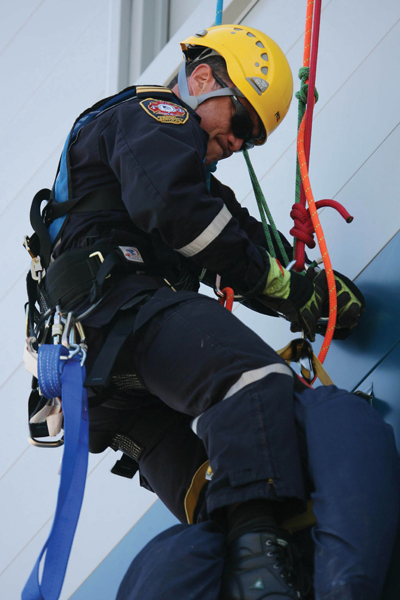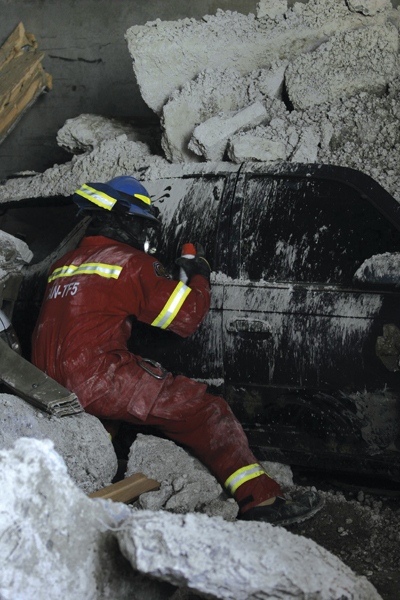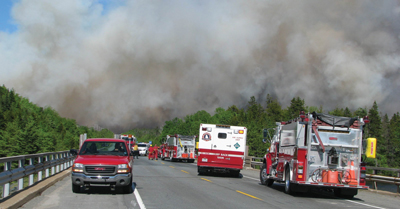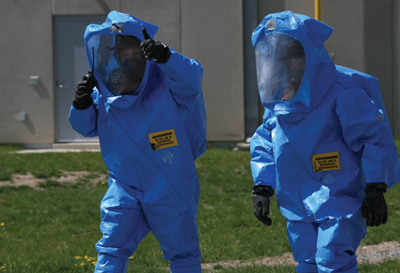
Features
Structural
Training
Specialized skills
With training time, proximity to training centres and funding for training cited in our recent Fire Fighting in Canada survey as major concerns, it’s clear that specialized training is not a priority for thousands of volunteer departments.
March 27, 2009
By James Careless
With training time, proximity to training centres and funding for training cited in our recent Fire Fighting in Canada survey as major concerns, it’s clear that specialized training is not a priority for thousands of volunteer departments.
 |
|
| Photo by John Riddell. Technical rope rescue is part of the NFPA 1001 1006-accredited firefighter training course.
|
But not all departments need to be all things to all people.
In volunteer departments, “everybody has jobs and families that restrict how much time they can devote to specialized skills training,” says Randy Vilneff, training officer for the Marmora & Lake Fire Department in Ontario.
“Getting people out for training is the biggest challenge.”
As a result, specialized skills like ice/water rescue training may be less in demand on the Prairies than in the Maritimes but high-angle and confined-space training for silo rescues is a must in farm regions.
Here’s a look at some specialized techniques, where and why they’re necessary and some budget-conscious training techniques.
Confined-space rescue
Confined-space rescue can apply to natural spaces such as caves or man-made spaces such as silos and mines. For firefighters, the key is to learn how to work safely when access and room to manoeuver are limited and good air may be at a premium.
In southwestern Ontario, “we have two businesses within our jurisdiction that have hoppers; one is a glass recycling plant and the other does wood processing,” says John Uptegrove; captain and training officer with the Puslinch Fire Department. “The problems occur when they try and clean the hoppers. Sometimes people get trapped in the material inside, and we have to send in rescuers to pull them out of tall, very narrow confined spaces.”
Training for confined space rescue requires knowledge in roping, rigging and air quality management. “We train by making sure the right rigging is in place onsite, then sending our people in with ropes to practice working in the space and attaching harnesses to victims to pull them out safely,” says Uptegrove. “We often have to use SCBA equipment – and train with it – because many of these spaces are not oxygen rich.”
Extrication
Typically, extrication refers to cutting victims out of damaged cars and trucks – freeing them while supporting the vehicle weight so that it does not further harm them or injure the rescuers.
In the strictest sense, “extrication is the act of removing the vehicle from around the patient,” says Vilneff.
The Marmora & Lake department is mid-way between Ottawa and Toronto on the Trans-Canada Highway and in a tourist area, he says. To do the job, “we use hand tools, heavy hydraulics, lifting air bags and stabilizing equipment.”
For training, the Marmora department takes its members out to the local auto wrecking yard in good weather, letting them take apart a few wrecks so that they can get a feel for the equipment. “I never cease to be amazed at how easily the cutters will slice through a car’s roof pillars,”
Vilneff says. The cost is negligible: the volunteers provide the time and the local auto yard provides the wrecks.
Dangerous goods
Biological, chemical, nuclear – just some of the material risks faced by officers on dangerous goods detail. Not surprisingly, dangerous goods or hazmat training is a sufficiently detailed skill that it is taught at the college level and in courses, rather than being left to the volunteers for an ad hoc weekend session. “We teach the NFPA’s
hazmat program at the college,” says Dez Shubert, an instructor at Lakeland College in Vermillion, Alta. “In the classroom, we start by teaching our students chemical and product recognition, then get into subject areas such as evacuation and supervision. Once they have this knowledge, we get them into the hazmat suits and start giving them hands-on experience.”
 |
|
| The federal government funds volunteer-based HUSAR teams in Vancouver, Calgary, Manitoba, Toronto and Halifax. Photo by John Hanley. |
Heavy urban search and rescue
Heavy urban search and rescue (HUSAR) is a specialty skill brought into focus after 9-11. It requires firefighters to become adept at supporting collapsed buildings – especially concrete – then creating safe zones in which rescuers can excavate and remove victims. Logistics also plays a key role in HUSAR work, with teams being expected to bring in everything they need to live and work for weeks at a time, if need be. In Canada, the federal government is funding volunteer-based HUSAR teams in Vancouver, Calgary, Manitoba, Toronto and Halifax. Federal funding also helps support department-specific HUSAR training in smaller jurisdictions.
High-angle rescue
Technical rope rescue can be deployed on cliff-side situations or high-rise buildings. In either case, the art is to use gravity to aid firefighters as they dangle on a rope, trying to use very specialized equipment and techniques to access the victim and have them hoisted to safety.
Lakeland College teaches technical rope rescue as part of its NFPA 1001 1006-accredited firefighter training course. “Since rope skills are vital to effective high angle rescue, we teach all aspects of rope work,” says Shubert. “We start with basic low-slope work, such as rescuing someone whose car has gone off the road on a steep bank. The training progresses until our students learn how to retrieve an injured window washer from the side of a high-rise.”
Ice and water rescue
In Canada, ice and water rescue is a regular part of most departments’ ongoing duties. Yet the task is sufficiently dangerous that careful training is required.
“Ice rescue requires some very specific skills,” says Ted Morrison, chief training officer with Ajax Fire & Emergency Services in Ontario.
“The officers have to learn how to work in dry suits, and how to approach the victim safely while remaining secured to land using ropes. Typically, we run our training by taking officers out onto a local pond when the weather’s gotten cold enough for it to freeze just a bit. We then put a dry-suited victim in the water and let the guys run through the drill.”
“Our area is dotted with water-filled gravel pits,” says Puslinch Fire & Rescue’s John Uptegrove. “People like to go there and party on the weekends, and some drown as a result. In fact, we’ve had two cars drive into water-filled pits. That’s why our people get out on the weekend to work with dry suits and boats, to learn in person what it is like to work in this environment.”
 |
|
| Knowledge of factors like wind direction and speed are crucial to wildfire training. Photo courtesy Halifax Regional Fire and Emergency. |
Industrial fire fighting
Suppressing industrial fires has to be one of the most thankless tasks for firefighters. They never really know what hazards they will encounter, and what dangerous materials may be involved in the blaze.
“The toughest part about industrial training is that the requirements vary from site to site,” says Shubert. “Each department has to investigate the industrial sites in their jurisdiction to decide what range of skills are required. Not only do you have to assess hazmat requirements and potential chemical risks – including what dangerous substances are on site and how they are stored – but you have to decide what skills may be required.”
The good news: “Most industrial sites have their own corporate fire departments, and they are usually very knowledgeable about what the risks are and how they are to be contained,” Shubert says. “The most difficult part is ensuring that the corporate department and your own are ready to work together effectively before something happens, which requires preplanning and co-ordination”.
 |
|
| Hazmat training is so specialized that in most cases it is taught at post-secondary institutions rather than at the department level. Photo by John Riddell. |
Wildland firefighting
Our final example of specialty firefighting is the very changeable wildland fire, governed by wind speeds and direction, available fuel sources and human carelessness. Unlike urban fires, wildland fires are extremely unpredictable and volatile. If the weather goes against you, sometimes containment is the only option and sometimes it doesn’t work.
“Wildland fires are extremely unique in their behaviour,” says Shubert. “For the urban firefighter, they represent real challenges because there are new tactics that have to be learned, including how to position and build fire breaks and trenches, how to work with limited water resources and so forth. This is a skill that requires real training to master.”
As the list above illustrates, there is a range of specialty fire fighting skills that your department may need to master, depending on the challenges in your territory. Trying to quantify the costs of such training is difficult, since such costs are based more on what a department can afford to spend versus how much it needs to spend.
As is often the case in Canada, our fire departments figure out what threats are the most prevalent, and train for them as best they can with the resources they’ve got.
Print this page